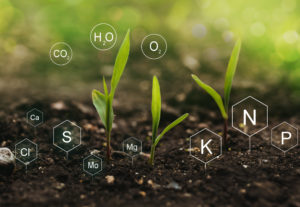Menu
Bringing Balance to Fertilizer Decisions
Entering a spring where costs are higher on most inputs in crop production leads to many discussions with growers about fertility inputs for this season.
The first and most important recommendation is to focus on balancing nutrients between the different elements. Because many vital nutrients are co-dependent, keeping the overall balance of nutrients in focus is a priority. Sometimes the cost of an individual component gives us pause to its importance for this growing season. However, if we choose to cut it out of our crop plan, it may have secondary implications because of its importance to the crop or its relationship to other vital nutrients. Build a balanced plan using soil and tissue tests to maintain proper balance of nutrients throughout the growing season.

Balance of nutrients is essential to maximize yields!
A second important area of focus is the pH of the soil because of its critical role in the nutrient availability of key components, such as potassium and many micronutrients. Available calcium is also an essential building block to cell wall development and strength of the structure in almost all crops.
The third area I want to remind us of is the importance of soil porosity, especially in the root zone. Getting oxygen into the root zone is vital to maximizing crop yields. Utilizing cover crops, crop rotations, and limiting wheel traffic when soils are wet all help reduce compaction. Soil health is also an essential part of maintaining adequate soil porosity. Earthworms, biologicals, and bacteria help break down crop residue, mixing these residues into the earth, and helping solubilize vital nutrients – all working together to build a healthy soil and a nutrient-rich root zone.
I want to share a fourth thought: “Should I feed the soil or the plant?” We have all had a sales person drive up with some fantastic product for sale, and a comment is offered, “If you do this, it will replace that.” Here at PowerAG we believe in foundational agronomy. Research has proven that it takes certain levels of crucial nutrients to produce a bushel of corn, soybeans, wheat, etc. So foundational agronomy means we start from the ground up. We encourage growers to do all they can to increase soil health and biological activity in the soil, and we sell and promote products that can enhance the physical process of solubilizing nutrients in the soil, making them more available to the crop. Feeding your soil first, building upon a solid fertility program is our recommendation. Then during the growing season, you can improve your crop’s chances of maximizing yields by timely applications of nutrients, applied either near the root zone or through foliar applications. Remember, the cuticle of the leaf has a limited ability to absorb nutrients, so a crop nutrient plan that lacks a solid soil base of nutrients cannot be fully restored to maximum yields exclusively through foliar applications.
So, to wrap it up, focus on the balance of nutrients vs. volume if your budget requires restraint. Add lime where needed; it may be your best dollar spent for the 2022 crop plan. Remember to do all you can to manage your soils – achieve a porosity that promotes oxygen, nutrients and moisture absorption into the root zone.
High yields don’t come by accident! Execute a good plan, build a solid fertility foundation, and then add to it when there is a chance you can add yield and profit to your bottom line.
From all of us at PowerAG, have a safe planting season.


